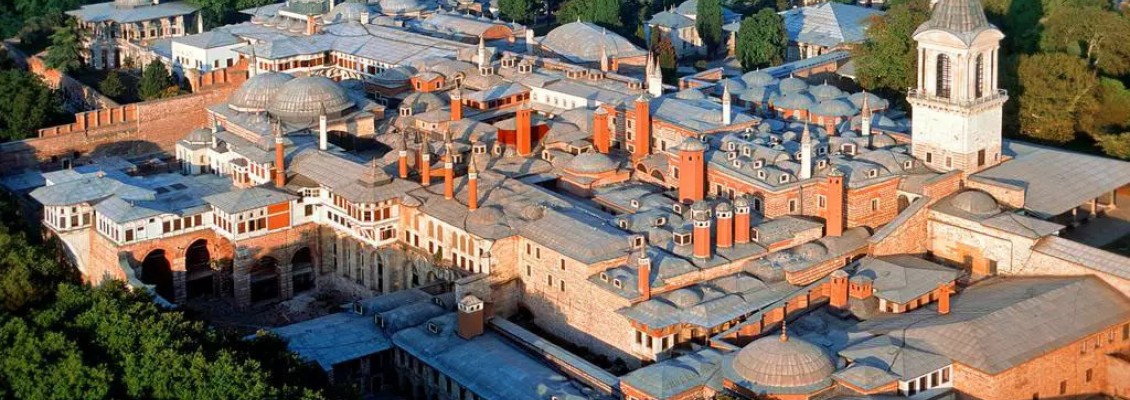
OTTOMAN TRACES IN ISTANBUL - 4
– PALACES
The Ottoman Empire ruled for more than 600 years, leaving behind a rich
historical legacy enjoyed by many people today. One such example would be the
Ottoman palaces, once inhabited by Sultans and their families. Palaces were not
only used as housing for Sultans, but also as venues for managing state
affairs. Today, we have the chance to visit a number of beautiful Istanbul
palaces, each reflecting the different styles of their time. Let’s take a look
at some of the palaces visitors can enjoy during their visit to İstanbul:
Topkapi Palace
Topkapi Palace is the most visited palace in Istanbul, thanks to its
location, superb architectural features and impressive size. After the conquest
of Istanbul, Fatih Sultan Mehmet (Mehmet the Conqueror) had a new palace built.
The construction of Topkapi Palace started in 1460 and was completed in 1478.
However, further additions were made to the palace up until the 19th century.
Topkapi Palace is arranged around four main courtyards and three monumental
gates. The vast area between the first gate and the second was where palace
employees took care of the needs of the palace, and the public was free to come
and go, as well as soldiers. This first courtyard was home to the Hagia Irene
Church, a mint, a bakery, a hospital, and a wood warehouse. Alay Square,
located between the second gate and the third gate, was the administrative
centre of the state, where important meetings were held. The third courtyard is
called Enderun Square. Enderun is where the Sultan and his servants lived, and
where palace education was carried out. The final courtyard is where the
pavilions are located, inhabited by the Sultans and their families.
Dolmabahçe Palace
The area where the Dolmabahçe Palace is located today used to be a large
bay along the coast of the Bosphorus Sea, where the Ottoman naval commanders
anchored ships until four centuries ago. Over the years it turned into a swamp,
and the area was filled in. In later years, people used this location for
different purposes and built various buildings such as gardens and pavilions.
The construction of Dolmabahçe Palace was ordered by Abdulmecid the First, who
wanted to build a modern palace with a more European style. The construction
took place between 1843 and 1856, and the palace functioned as the main
administrative centre of the Ottoman Empire from 1856 to 1887, and then from
1909 to 1922. Six Ottoman Sultans used this palace until it was taken over by
the Turkish Republic. The palace was first opened to tourists in 1930, when it
hosted the European meeting of the Alliance Internationale de Tourisme.
Beylerbeyi Palace
Located on the Anatolian side of Istanbul, Beylerbeyi Palace was built
between 1863 and 1865. All the previous buildings in the area, which had been
used as private gardens for a while during the Ottoman Empire, were demolished
during the reign of Mustafa III (1757–1774) and the land was sold to the
public. A palace made of wood was later built in the area, but half of it burnt
down in a fire. The other half of this wooden palace was demolished and the
Beylerbeyi Palace we see today was commissioned by Sultan Abdülaziz
(1830–1876). The palace was used as a summer residence and a place to entertain
visiting heads of state. The first prominent guest of Beylerbeyi Palace was
Napoleon the Third's wife, Empress Eugénie of France. During the reign of Abdülhamid II
(1876-1909), Beylerbeyi Palace also functioned as a museum visited by foreign
state delegations. Beylerbeyi Palace, Dolmabahçe Palace and Topkapı Palace were
used as sultanate museums that could be visited with the permission of the
Sultan at the time.
Yıldız Palace
Yıldız Palace is a glamorous example of Turkish Ottoman palace
architecture. It was commissioned by Selim III, with a pavilion for his mother
Mihrişah Sultan. A rococo-style fountain was also constructed for his father,
Mustafa III. Other structures like pavilions and mansions were later added
later by subsequent Sultans. During the reign of Abdulhamid II (1876-1909),
Yıldız Palace took over from Dolmabahçe Palace as centre of state affairs.

Leave a Comment